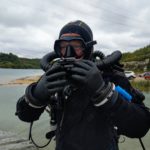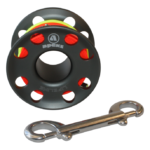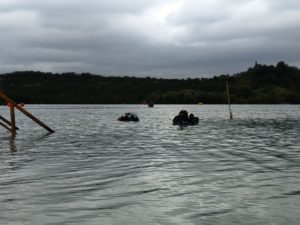Technical diving was a male-dominated sport for a long time, but today you can see changes. The odds are becoming more even and the opportunities are increasing from day to day, so here too is a female group growing. Cylinders, stages and rebreather’s weights are what most women fear the most. But other questions and doubts also arise.
We did not manage to find Polish research on the impact of deep diving on the female body, but we came across an article that clarifies a few issues as much as possible. Some of the information comes from research conducted at the end of the 20th century, mainly in the United States. Research on human organisms is always limited by ethics, therefore scientists rarely decide to carry out or repeat them (e.g. the impact of deep diving on the course of pregnancy at various stages), and the results and conclusions drawn so far are considered the basis for recommendations for undertaking the diving activity.
Apart from the individual issues, it cannot be denied that a woman’s body is different from a man’s. A different hormonal economy is very important here, as are cosmetic or surgical procedures.
DECOMPRESSION SICKNES (DCS)
 The first problem that has been considered and has been relatively best researched is the problem of decompression sickness. In the case of healthy men and women, no correlation was found between gender and the incidence of DCI. Nevertheless, in the case of women, when oral contraceptives are used, and even more so when combined with smoking, their incidence increases significantly. This is neither surprising nor definitely related to diving. The risks of combining nicotine with an oral contraceptive are extensively described on each package insert, and the prescribing physician always asks about smoking. However, the environment we will find ourselves in while diving can make the potential danger more real. A slight correlation was also observed depending on the day of the cycle. There is a question of the frequency of DCI symptoms and their severity.
The first problem that has been considered and has been relatively best researched is the problem of decompression sickness. In the case of healthy men and women, no correlation was found between gender and the incidence of DCI. Nevertheless, in the case of women, when oral contraceptives are used, and even more so when combined with smoking, their incidence increases significantly. This is neither surprising nor definitely related to diving. The risks of combining nicotine with an oral contraceptive are extensively described on each package insert, and the prescribing physician always asks about smoking. However, the environment we will find ourselves in while diving can make the potential danger more real. A slight correlation was also observed depending on the day of the cycle. There is a question of the frequency of DCI symptoms and their severity.
In 2006, Marguerite St. Leger Dowse analysed information from over 50,000 dives and 11,000 menstrual cycles in 570 women. It turned out that the most common diving problems occurred in the first week of the 28-day cycle and the lowest risk occurred in the third week of the cycle. The mechanism of the risk of decompression sickness in the menstrual cycle is unknown, but fluctuations in hormones may be a potential factor that increases it.
CONTRACEPTION
Meanwhile, oral hormonal contraception is one of the most popular methods used by women. At the same time, however, it has a drawback: it has been shown that birth control pills can significantly increase the risk of blood clots causing a stroke, heart attack, deep vein thrombosis (blood clots in the legs) and pulmonary embolism (blood clots in the lungs). Women who smoke are (again!) the most vulnerable. While women under the age of 25 who use birth control pills do not have an increased risk of thrombosis compared with non-smokers who do not use birth control pills, the risk of developing these diseases is much higher for women who smoke. However, it must be remembered that “randomly” chosen and applied measures can do the same harm without the tobacco context.
PREGNANCY AND BIRTH
 Research and data on diving in pregnancy are mostly quite old. The ones that can be mentioned are the 1980 studies by Melvin D. Bolton, which proved that the fetuses of diving mothers were deformed as a result of pressure conditions. In 2006, St. Leger Dowse published in Obstetrics and Gynecology retrospective data from 1990-1992 and prospective data from 1996-2000 on 129 women who continued diving, intentionally or unintentionally, during pregnancy. They included 1,465 dives during 157 pregnancies. It’s worth noting that while only 65% of women stopped diving in the first trimester between 1990 and 1992, the figure rose to 90% between 1996 and 2000. In the entire population, spontaneous miscarriages accounted for 14%, and the rate of serious birth defects was 2.7%, which is similar to the rate in those who dived without being aware of their pregnancy.
Research and data on diving in pregnancy are mostly quite old. The ones that can be mentioned are the 1980 studies by Melvin D. Bolton, which proved that the fetuses of diving mothers were deformed as a result of pressure conditions. In 2006, St. Leger Dowse published in Obstetrics and Gynecology retrospective data from 1990-1992 and prospective data from 1996-2000 on 129 women who continued diving, intentionally or unintentionally, during pregnancy. They included 1,465 dives during 157 pregnancies. It’s worth noting that while only 65% of women stopped diving in the first trimester between 1990 and 1992, the figure rose to 90% between 1996 and 2000. In the entire population, spontaneous miscarriages accounted for 14%, and the rate of serious birth defects was 2.7%, which is similar to the rate in those who dived without being aware of their pregnancy.
There are other non-decompression related problems with diving during pregnancy. Pregnancy causes an increase in water in the body and retention and swelling of the mucous membranes. Two-thirds of women experience nausea and vomiting or “morning sickness” in the early stages of pregnancy. Additionally, acid reflux (heartburn) is very common.
Rekomenduje się, by po porodzie pochwowym kobieta powstrzmała się od nurkowania przez 21 dni, aby dać czas na zamknięcie szyjki macicy i zmniejszyć ryzyko wystąpienia infekcji. Po cesarskim cięciu większość położników zaleca powstrzymanie się od nurkowania przez 4-6 tygodni.
Również nurkowania podczas karmienia piersią są obarczone ryzykiem kolonizacji bakterii morskich na skórze, co skutkuje zwykle zapaleniem sutka u matki i biegunką bakteryjną u niemowlęcia.
PLASTIC SURGERY – IMPLANTS
In the 1980s, when aesthetic medicine and plastic surgery began to develop quickly, research began on the influence of pressure on salt and silicone implants. Research conducted by Dr. Richard Vann from the Duke University Medical Center showed that despite the change in volume (1-4%), there was no danger of rupture. However, what is worth avoiding in such a situation are fastening straps that wrap around the chest at this exact level. Salt implants turned out to be neutral in terms of buoyancy, while silicone implants are heavier so this should be considered as additional ballast. Following breast augmentation surgery, it is recommended to wait 4-6 weeks before returning to diving and to avoid wearing tight shoulder straps over the implants to avoid excessive pressure.
OSTEOPOROSIS AND MENOPAUSE
22% of female divers who perform more than eight dives per year are 55 years or older. During menopause, women are at greater risk of osteoporosis than men because of lower baseline bone density and loss of estrogen, which accelerates the rate of bone demineralization. The average age of entering menopause is 50 years (on average between 45 and 55), and this is also when bone loss occurs. Bone demineralization becomes more visible around the age of 60–70, and the frequency of fractures increases around the age of 70–75. Although effective supplementation and treatment methods already exist, women with osteoporosis should exercise caution when wearing scuba cylinders because of the increased risk of injury and fracture.
CONCLUSIONS
- Women are more likely to develop decompression sickness in the first week of their period.
- The increased risk of decompression sickness for women using oral contraceptives is unclear.
- Women, especially those using oral contraceptives, are at increased health risk if they smoke.
- A female diver should stop diving as soon as she learns or suspects that she is pregnant.
- Breast implants may swell when moving from a hyperbaric (diving) to a hypobaric (air travel) environment, but not enough to risk rupture.
- As we age, osteoporosis can expose women to compression fractures in the spine.
- Cardiovascular health is just as important for women as it is for men.
While women’s issues have been discussed, remember that any diver, regardless of gender, should be vigilant in controlling risk factors for cardiovascular disease. Regular blood pressure and cholesterol checks, screening and treating diabetes, and avoiding smoking, not to mention exercise and weight control, are the same for a diver as regular checks of equipment: cylinders, vending machines, computers.
PS. If you have found more recent data on this subject, let us know in the comments. We will be happy to read them and update the information.
Sources:
https://gue.com/blog/tech-sisterhood-under-pressure/
Czynniki ryzyka nurkowania, tworzenie się pęcherzyków gazu i choroba dekompresyjna w nurkowaniu rekreacyjnym SCUBA: Analiza bazy danych DAN Europe DSL
https://www.diversalertnetwork.org/medical/faq/Breast_Implants
https://europepmc.org/article/MED/7423656
Absolwentka Uniwersytetu Warszawskiego. Do 2020 r. sekretarz redakcji czasopisma „Szkło i Ceramika” (ICiMB, SITPMB). Zafascynowana szkłem i ceramiką w każdym aspekcie ich powstawania i wykorzystania, w tym historycznymi technikami i technologiami wytwarzania, zdobienia i łączenia z innymi materiałami. Obecnie prowadzi własny portal Szklo-Ceramika.ONLINE i angażuje się w projekty tematyczne
An IT network engineer by profession. A passionate diver. Active diving instructor and EFR (Emergency First Response & Secondary Care) instructor. Technical diver TDI Advanced Trimix Open Circuit and X-CCR Normoxic Trimix. Closed circuit diving enthusiast.
Z zawodu inżynier sieci informatycznych. Z zamiłowania płetwonurek. Czynny instruktor nurkowania oraz instruktor EFR (Emergency First Response & Secondary Care). Nurek techniczny TDI Advanced Trimix Open Circuit i X-CCR Normoxic Trimix. Entuzjasta nurkowania na obiegu zamkniętym na X-CCR.
















11 lat temu w swojej książce ” Nurkująca kobieta” opisałam większość problemów, które dotyczą nurkujących kobiet, a które zostały opisane w tym artykule. Koledzy nurkowie, lekarze , na moją prośbę, wypowiedzieli się na tematy nas w nurkowaniu dotyczące, na które pozwalała ich wiedza. Miesiąc po publikacji mojej książki ukazało się obszerne opracowanie w j. angielskim, oparte na wieloletnich badaniach na nurkujących kobietach, która potwierdziło chyba wszystkie moje spostrzeżenia. Na polskim rynku ” Nurkująca kobieta” to w dalszym ciągu jedyne tak szerokie opracowanie tego tematu.
Dorota Łeweć
Bardzo dziękujemy za odzew. Przyznam, że jak na 11 lat, to niewiele się zmieniło w tej kwestii, a trochę szkoda, bo ten sport przestał być już “sportem męskim”.